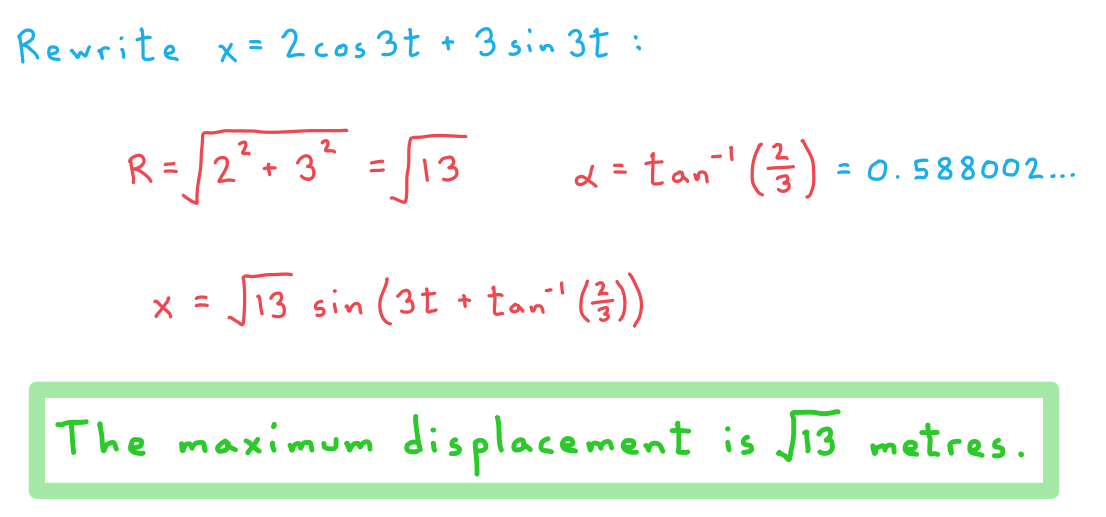Simple Harmonic Motion (Edexcel A Level Further Maths): Revision Note
Exam code: 9FM0
Simple harmonic motion (SHM) equations
What is simple harmonic motion?
A particle undergoing simple harmonic motion moves along a straight line subject to the following constraints:
The acceleration of the particle is always directed towards a fixed point on the line of motion
The acceleration is proportional to the displacement of the particle from the fixed point
As a result the particle oscillates back and forth along the line around the fixed point
Many physical systems can be modelled using simple harmonic motion
One example is an object attached to a spring oscillating in one dimension, when friction, air resistance and other such resistive forces are disregarded
What is the equation that describes simple harmonic motion?
The standard form of the simple harmonic motion equation is
x is the displacement of the particle from the fixed point
The fixed point is normally indicated by O and is the origin (i.e. zero point) of the coordinate system
The fixed point O is known as the centre of oscillation
is the constant of proportionality, and represents the strength of the force accelerating the particle back towards point O
The negative sign means that the acceleration is always directed back towards O
We use
to assure that the constant is positive, and also to simplify the notation for the solution to the equation
is the acceleration of the particle
With simple harmonic motion, Newton’s ‘dot notation’ is often used for the derivatives
In this notation,
and
Solutions to SHM equations
What is the solution to the standard simple harmonic motion equation?
The SHM equation may be solved using the standard techniques for second order differential equations
may be rearranged to give the homogeneous second order equation
That has auxiliary equation
with roots
Therefore the general solution is
Initial or boundary conditions given with a question may allow you to find the precise values of the arbitrary constants A and B
The linear combination of sine and cosine terms in the general solution may be rewritten in the form
This can sometimes be a more useful form for the general solution
This form of the equation shows that the particle oscillates around the fixed point O (i.e., around the centre of oscillation)
The amplitude of the motion is R
This is the maximum distance that the particle moves away from the fixed point O
The period of the motion is
This is the length of time it takes the particle to complete one oscillation
The constant α is a ‘phase constant’
If α = 0, then the particle is at point O (i.e., x = 0) when t = 0
If
then the particle is at its maximum displacement (i.e., x = R) when t = 0
How can I solve the simple harmonic motion equation to link displacement x and velocity v?
Because acceleration is the derivative of velocity, and velocity is the derivative of displacement, we may use the chain rule to write
Substituting that into the standard SHM equation gives
That form of the SHM equation may be solved using separation of variables:
But the velocity is momentarily zero when the particle reaches its maximum displacement
After this the particle’s velocity changes direction and the particle heads back towards the centre of oscillation
This gives us a boundary condition (because we know that v = 0 when x = R) and allows us to find the value of the constant of integration:
Substituting that value of c into the solution and rearranging gives
where R again is the amplitude of the simple harmonic motion
Note that this version of the solution connects the velocity v to the displacement x, and is independent of the time t
Taking square roots gives
Be careful when using this to answer questions
The direction of the velocity (plus or minus) will depend on the displacement (plus or minus) and whether the particle is moving towards or away from the centre of oscillation
Examiner Tips and Tricks
Even though you may have memorised the forms of the solutions for the SHM equation, it is important on an exam question to derive the solution ‘from scratch’, showing your method and working
Worked Example
A particle is moving along a straight line. At time t seconds its displacement x metres from a fixed point O is such that . At time t = 0, x = 2 and the velocity of the particle is 9 ms-1.
a) Find an expression for the displacement of the particle at time t seconds.

b) Hence determine the maximum displacement of the particle from O.

c) Show that the relationship between the velocity v and displacement x of the particle may be described by the equation .


Unlock more, it's free!
Did this page help you?